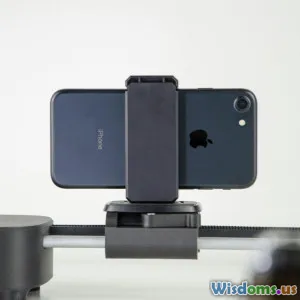
Mobile Filmmaking Techniques
7 min read Explore transformative mobile filmmaking techniques to create compelling films using your smartphone. (0 Reviews)
Mobile Filmmaking Techniques: Elevate Your Cinema with a Smartphone
Mobile filmmaking has revolutionized the world of visual storytelling, making it accessible to anyone with a smartphone. Today, blockbuster films, award-winning documentaries, and viral videos alike are frequently captured on devices we carry daily. This shift is fueled by advancements in mobile camera technology and a growing library of accessible tools and techniques.
Whether you’re a beginner wanting to explore the craft or an experienced filmmaker seeking to adapt to this mobile-first era, this article provides comprehensive insights to enhance your mobile filmmaking game.
Why Mobile Filmmaking Matters
In 2020, the film "Searching" showcased compelling storytelling done predominantly on smartphones, breaking conventional barriers. This landmark shed light on the possibilities mobile devices hold, not just as backups but as primary tools for capturing narrative depth with immediacy and intimacy.
Mobile filmmaking democratizes video creation by eliminating the need for costly equipment, enabling creators worldwide—from bustling cities to remote villages—to tell their stories.
Mastering Mobile Filmmaking Techniques
1. Understanding Your Device's Capabilities
Each smartphone comes with unique camera capabilities, such as sensor size, aperture, and frame rate options. For instance, the iPhone 14 Pro Max offers Dolby Vision HDR recording at 4K resolution, while flagship Android devices like the Samsung Galaxy S23 Ultra support 8K video.
Knowing your phone’s strengths helps you tailor your shoot: is low-light performance crucial? Promote scenes in golden hour to take advantage of natural light and avoid noisy images. Does your phone offer manual controls? Apps like Filmic Pro unlock advanced settings like ISO, shutter speed, and white balance.
2. Composition and Framing: The Story Within the Frame
Effective storytelling begins with framing. Utilize the rule of thirds to position subjects strategically and create visual interest. Experiment with leading lines and depth to add layers to your narrative.
For example, in urban settings, use architectural elements like staircases or bridges to guide the viewer’s eye toward a character, heightening suspense or focus.
3. Lighting: Sculpting with Light
Lighting can make or break your film’s atmosphere. When natural light is available, use reflectors (even simple white boards) to bounce light and fill shadows. For shoots in limited light, affordable portable LED panels can provide consistent illumination.
Filmmaker Ryan Connolly emphasizes, "Light doesn’t just show you an image—it tells a story. Use it intentionally to develop mood and character."
4. Stabilization Techniques
Smartphones are lightweight, which unfortunately also means susceptible to shaky footage. Invest in a gimbal stabilizer such as the DJI Osmo Mobile or Zhiyun Smooth series for fluid, cinematic movement.
If equipment isn’t available, employ in-body or app-based digital stabilization, shoot with both hands, use your environment (leaning on walls or tables), and keep movements slow and deliberate.
5. Audio Matters: Capturing Pristine Sound
Visuals alone don’t make a film immersive. Good quality audio is vital to engage viewers. Built-in microphones can pick up ambient noise and wind, so augment them with external microphones like lavaliers or shotgun mics compatible via TRRS or USB-C.
Apps like Rode Reporter allow fine audio monitoring. In post-production, software such as Adobe Premiere Rush offers sufficient tools for noise reduction and clarity.
6. Creative Use of Lenses and Filters
Mobile-compatible lenses like Moment’s anamorphic attachment open new visual styles, delivering wide cinematic aspects and unique flares.
Polarizing filters reduce glare and enhance colors, perfect for outdoor scenes. ND (Neutral Density) filters allow shooting in bright conditions without overexposing, enabling wider apertures or slower shutter speeds.
7. Editing on the Go
Mobile filmmaking is incomplete without editing. Lightweight editing apps such as LumaFusion (iOS) or Adobe Premiere Rush (Android & iOS) offer multi-track editing, color grading, transitions, and titling on the device itself.
Edit with storytelling intent by cutting tight, balancing pacing and dynamics, and color grading to set mood. Use original sound design or royalty-free music to heighten emotional impact.
Real-World Insights: Stories from Mobile Filmmakers
Filmmaker Sean Baker’s critically acclaimed film "Tangerine" was shot entirely on an iPhone 5S, proving that creativity triumphs over equipment limitations. Its success lies in a strong script, authentic performances, and smart cinematic decisions.
Similarly, independent creators use mobile filmmaking for rapid-turnaround news stories, offering immediate, raw insights from the field directly shared on digital platforms.
Conclusion: Empower Your Filmmaking Journey
Mobile filmmaking is more than a trend—it’s an empowering movement reshaping visual narrative. By mastering your smartphone’s capabilities, understanding light and sound, stabilizing footage, and embracing creative storytelling, you unlock vast potential.
Start small: plan your shots carefully, experiment boldly, and refine your craft with each project. As technology advances, the only limit to what you can create is your imagination.
Embrace your mobile device as a cinematic tool and contribute your voice to the evolving language of film.
Recommended Resources:
- Filmic Pro app for manual control: https://filmicpro.com/
- Moment lenses and accessories: https://www.shopmoment.com/
- LumaFusion app for mobile editing: https://luma-touch.com/
- DJI Osmo Mobile gimbals: https://www.dji.com/osmo-mobile
Quote source: Ryan Connolly, "Film Riot" YouTube Channel
Unlocking the power of mobile filmmaking starts with technique and intention. With these practical tips and inspiring examples, you're equipped to create cinematic stories wherever you go.
Rate the Post
User Reviews
Popular Posts





















